Features
“Agent Sonya” – the story of the Soviet Union’s most important female spy
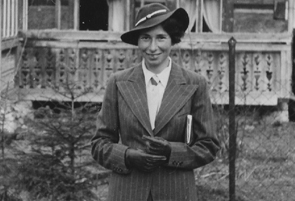
Reviewed by BERNIE BELLAN I happened to have the radio on one Saturday afternoon – more as background noise than anything, when Elanor Wachtel’s CBC program on books, “Writers & Company”, came on. Normally I don’t pay attention to Wachtel’s program because it requires paying complete attention to the radio – something which I rarely do unless I’m out for a walk. However, as soon as Wachtel began to introduce her guest, a writer by the name of Ben Macintyre, the subject matter immediately grabbed my interest. Here is how she introduced Macintyre:
“Mrs. Len Beurton of Great Rollright, a tiny village in the Cotswolds, was an apparently ordinary housewife and mother of three, famous for her home-baked scones.
“In reality, she was Agent Sonya, a top Soviet operative, transmitting plans for the atomic bomb from an outhouse in her Oxfordshire garden. Her real name was Ursula Kuczynski and her intelligence work took her from her native Germany to Shanghai, Japanese-occupied Manchuria, Poland, Switzerland and England.
“Ursula’s eventful life is the subject of Ben Macintyre’s compelling new book. The British journalist is known for his bestselling accounts of international espionage — stories of intrigue, romance, betrayal, war, loyalty and conflicted morality. Over the past 30 years, he’s produced a dozen engaging, authoritative studies of high-profile figures ranging from Britain’s famed double agent Kim Philby to Moscow’s Oleg Gordievsky, who spied for Britain. He is also currently a columnist and associate editor for the Times U.K.”
As I listened with rapt interest to Macintyre describing the life of “Agent Sonya” I was determined to read his book – and I did, in less than a week.
Now, while I have somewhat of an interest in spy thrillers, including several I’ve read by Daniel Silva who features an Israeli spymaster by the name of Gabriel Allon (after being turned on to Silva two years ago during one of the meetings of the book club this paper co-sponsors with the Rady JCC, when our brilliant convener Sharon Freed who, unfortunately died much too young, included Silva’s “Rembrandt Affair” on the reading list that year), I much prefer reading non-fiction accounts of espionage, especially when they’re about the Mossad.
So, when Macintyre began to relate the story of an incredibly successful female spy for the Russians whose story has gone relatively unreported – and then happened to remark that she was Jewish to boot – well, he had me hooked.
Sonya Buerton (born Ursula Kuczynski, a.k.a. Sonya Hambuerger) was one of those rare individuals who not only succeeded brilliantly at her craft, she managed to live out her days dying a natural death in Moscow in the 1970s. That she survived the Stalin era in itself is rather extraordinary as Stalin’s paranoia led him to purge the ranks of his spy network on an ongoing basis – including a good many of the agents who had nurtured Sonya’s own career.
The fact that Ursula Kuczynski was born into an upper class Jewish family in Berlin in 1908 is something that I found most intriguing. The often pivotal roles that many Jews played in the spread of communist ideology in the first few decades of the 20th century is something that is widely known, but reading about someone who came from quite a prosperous family and who chose to commit herself to the pursuit of an ideology that was essentially antithetical to her own upbringing – and remained absolutely committed to that vision throughout her life, is not easy to understand.
Having experienced the chaos of the Weimar Republic in Germany one might well comprehend how someone as intelligent and well-educated as Ursula would have been drawn to communism in her late teens – at a time when Germany was being polarized into two camps – fascist and communist. It doesn’t seem, however, that the Kuczynski family’s being Jewish had much to do with what eventually became a thoroughly unquestioning loyalty to Soviet Communist ideology on the part of everyone of its members, including Ursula’s father, brother, and four sisters. That Ursula remained committed to communism throughout her life, however, despite all the betrayals of its goals perpetrated by Stalin and his disciples, is much more difficult to understand.
Macintryre doesn’t spend much time exploring the lure that communism held for Jews, but what I found particularly unsettling is how each member of this family was able to rationalize Stalin’s atrocities. Further, when the Russian Foreign Minister Molotov and his German counterpart Von Ribbentrop signed their non-aggression pact in 1939, the fact that so many communist sympathizers were able to twist themselves into pretzels defending a total betrayal of everything they had been espousing when it came to fighting fascism is really an indication how easily communist sympathizers could justify a 180 degree reversal in thinking without much compunction.
Ursula’s life, as told by Macintyre, was thoroughly documented throughout her lifetime, by her and by others, who kept detailed accounts all through the 1920s, 30s, and 40s. It turned out that Ursula was actually an excellent writer and her journals were not only detailed and very readable, when she eventually managed to escape to the Soviet Union shortly after the end of World War II, she managed to turn her fine writing talent into a craft as a writer of spy thrillers under the pen name “Ruth Werner”. (Her books, written in Russian and translated into several languages, actually sold quite well. As Macintyre notes, Ursula was merely one more former spy who was able to use their own experiences in order to turn out masterful spy novels. Included in that group also were Graham Greene and John Le Carré.)
Yet, as much as Ursula’s being Jewish does not play a central role in “Agent Sonya”, consider this: Her first marriage was also to a fellow Jew, an architect by the name of Rudolf Hamburger. Hamburger himself had no interest in Ursula’s communist leanings early on, and he was rather successful as an architect. But, in one of the most surprising twists in the story, once he and Ursula moved to China, where he helped to design some of the famous buildings along Shanghai’s Bund, and Ursula was first approached with the idea of becoming a Russian spy, even all the while that their marriage was falling apart, Hamburger was gradually transforming into a communist himself.
Further, even after Ursula left him – and the child that she bore while married to him, Hamburger became convinced that he too had to become a Russian spy! All the while he still loved Ursula too, even after he learned that she had become pregnant by another man and then again, by yet a third man.
It was in China that Ursula became a full-fledged Russian spy – with a change of name to Sonya. Several characters played key roles in leading to Ursula’s gradual induction into the world of Soviet espionage, including an America writer by the name of Agnes Smedley – a larger than life character who eventually became a leading apologist for Mao Tse Tung’s totalitarian rule.
The cast of characters in “Agent Sonya” is riveting. What Macintryre does so brilliantly is describe how ordinary individuals who would not stand out in any exceptional way possess the key ingredients that it takes to be a successful spy, including, among others: resourcefulness, an exceptional ability to lie one’s way through any situation, and what Ursula Kuczynski apparently possessed in spades: an ability to thoroughly compartmentalize one’s life.
Here we have a woman who, on the one hand, is a capable housewife – and mother – to three different children, by three different men no less! (and the children actually move with her from time to time as she’s relocated by her Soviet spymasters to different locations around the world, including Manchuria, Poland, Switzerland, and finally Britain), at the same time as she is able to insinuate herself into the upper echelons of enemy administrations wherever she is based.
In one passage that I found particularly compelling, “Sonya” describes how difficult it often was for her to sleep – and dream, without finding all the contradictory aspects of her various secret lives running up against one another. All the while she did this without resorting to alcohol or drugs – which is what almost inevitably become the crutches upon which spies lean. That she was also able to move from relationship to relationship with different men – twice at the order of her Soviet spymasters, and actually have honestly warm relationships with them to the point where she did love them yet, when ordered to leave those men, embark on a new assignment, is testament to her total acceptance of her role.
Here’s another interesting note about Sonya: As much as the intelligence she provided about various enemies, including: Chinese Republicans in Shanghai, Japanese occupiers in Manchuria, and German Nazis in Switzerland, was of great value to Russian intelligence, it was when she was able to move to England in 1941 that her greatest espionage coup was to come.
Living in a nondescript farmhouse in an out of the way village not too far from Oxfordshire – and by this time her name was now Sonya Buerton (the last man to whom she was married was also a spy by the name of Len Buerton), she was put in touch with a German-born scientist by the name of Klaus Fuchs. Fuchs was a brilliant physicist who was working on Britain’s own plan to develop an atomic bomb – separate and apart from what the Americans were doing at the same time. He was, however, a devout communist and determined to share whatever secrets he could with the Russians.
Sonya became his intermediary through which he was able to pass along reams of information to the Russians that proved to be of incalculable value in helping the Russians to leap frog what would undoubtedly have taken them years more to acquire on their own. Later, he moved to the U.S. to work on the fabled Manhattan Project. It was while he was in the U.S. that he had a change of heart, however, and turned himself in as a spy to the Americans. At the same time, though, he never betrayed Sonya.
Macintyre asks repeatedly how it was that Sonya was never caught by British intelligence, despite all the evidence that had been pointing for quite some time in her direction. Although he doesn’t arrive at a definitive conclusion, he suggests that more than anything, it was the total incompetence of the head of MI5 (Britain’s internal intelligence service), someone by the name of Roger Hollis, that led to Sonya’s being able to evade arrest.
At the time there was only one woman in a senior position in MI5, whose name was Millicent Bagot. Bagot was a dedicated – and thoroughly competent spychaser, far better qualified in her position than Hollis, who never believed that a woman could be a successful spy. Bagot was actually convinced early on that Sonya was a Russian agent and she bitterly fought to keep her from being allowed to enter Britain in 1941.
There is more than a little irony in the fact that one of Russia’s most successful spies of all time was a woman who was able to carry on her espionage precisely because she was a woman, while the one individual who would undoubtedly have been able to expose Sonya was also a woman but whose abilities were constantly underestimated, just as Sonya’s were, surrounded as she was by thick headed men.
“Agent Sonya” is a thoroughly compelling read. While the fact that Sonya was Jewish may be regarded as largely irrelevant to what became the story of her life since it never seemed to play any role in what ultimately ensued, I’m sure that for Jewish readers of this book the awareness that the person they are reading about was Jewish will lead to one’s wondering whether her being Jewish played a much larger role in her story than perhaps even Sonya herself was aware.
Here’s what Macintrye himself has to say in summing up Ursula’s life toward the end of his book: “If you had visited the quaint English village of Great Rollright in 1945, you might have spotted a thin, dark-haired and unusually elegant woman emerging from a stone farmhouse called The Firs, and climbing on to her bicycle. She had three children and a husband, Len, who worked in the nearby aluminium factory. She was friendly but reserved, and spoke English with a faint accent. She baked excellent cakes. Her neighbours in the Cotswolds knew little about her.
“They did not know that the woman they called ‘Mrs Burton’ was really Colonel Ursula Kuczynski of the Red Army, a dedicated communist, a decorated Soviet military intelligence officer and a highly-trained spy who had conducted espionage operations in China, Poland and Switzerland, before coming to Britain on Moscow’s orders. They did not know that her three children each had a different father, nor that her husband was also a secret agent. They were unaware that she was a German Jew, a fanatical opponent of Nazism who had spied against the fascists during the Second World War and was now spying on Britain and America in the new Cold War. They did not know that in the outdoor privy behind The Firs, Mrs Burton had constructed a powerful radio transmitter tuned to Soviet intelligence headquarters in Moscow. The villagers of Great Rollright did not know that in her last mission of the war, Mrs Burton had infiltrated communist spies into a top-secret American operation parachuting anti-Nazi agents into the dying Third Reich. These “Good Germans” were supposedly spying for America; in reality, they were working for Colonel Kuczynski of Great Rollright.
“But Mrs Burton’s most important undercover job was one that would shape the future of the world: she was helping the Soviet Union to build the atom bomb.
“For years, Ursula had run a network of communist spies deep inside Britain’s atomic weapons research programme, passing on information to Moscow that would eventually enable Soviet scientists to assemble their own nuclear device. She was fully engaged in village life; her scones were the envy of Great Rollright. But in her parallel, hidden life she was responsible, in part, for maintaining the balance of power between East and West and (she believed) preventing nuclear war by stealing the science of atomic weaponry from one side to give to the other. When she hopped on to her bike with her ration book and carrier bags, Mrs Burton (or, more precisely, Beurton) was going shopping for lethal secrets.
“Ursula Kuczynski was a mother, housewife, novelist, expert radio technician, spymaster, courier, saboteur, bomb-maker, Cold Warrior and secret agent, all at the same time.”
“Agent Sonya” – the story of the Soviet Union’s most important female spy
“Agent Sonya”
By Ben Macintyre
354 pages
Published Sept., 2020
Available on Amazon
Features
Japanese Straightening/Hair Rebonding at SETS on Corydon

Japanese Straightening is a hair straightening process invented in Japan that has swept America.

Features
History of the Winnipeg Beach Synagogue: 1950-2025

By BERNIE BELLAN The history of the Winnipeg Beach Synagogue is a fascinating one. We have had several articles over the years about the synagogue in The Jewish Post & News.

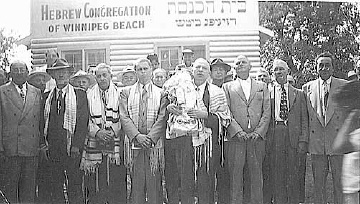
In June 2010 I wrote an article for The Jewish Post & News upon the 60th anniversary of the synagogue’s opening. Here are the opening paragraphs from that article:
“Sixty years ago a group of Winnipeg Beach vacationers decided that what their vacation area lacked was a synagogue. As it happened, a log cabin one-room schoolhouse in the Beausejour area happened to be available.
“In due course, the log cabin was relocated to the corner of Hazel and Grove in Winnipeg Beach, where it stayed for 48 years.”

In December 1994 my late brother, Matt, wrote a story about the spraying of antisemitic grafitti on the synagogue which, at that time, was still situated at its original location on the corner of Hazel and Grove in the town of Winnipeg Beach:
“Two 16-year-olds spraypainted slogans like ‘Die Jews,’ ‘I’ll kill you Jews,’ and other grafitti in big letters on the beach synagogue.
“Jim Mosher, a news reporter for the Interlake Spectator in Gimli, said last Halloween’s vandalism against the synagogue wasn’t the first. In the late 1980s, he claimed, it was spraypainted with swastikas.
“Jack Markson, a longtime member of the Winnipeg Beach Synagogue, last week also said he could remember finding anti-Semitic grafitti spraypainted on the synagogue ‘a few years ago,’ and at least twice in the 1970s, when the cottage season was over.”
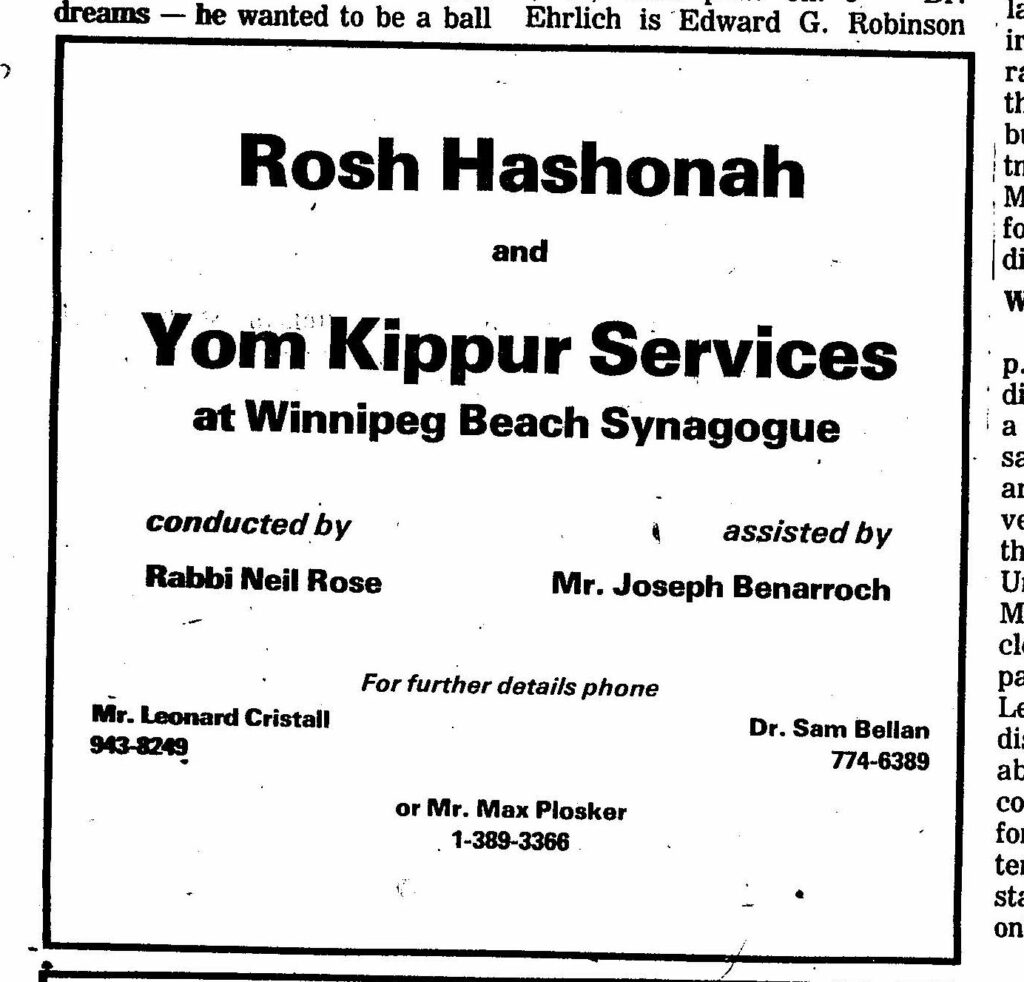
My 2010 article continued: “In 1998 the Town of Winnipeg Beach informed the members of the synagogue that the building would have to be hooked up to the town’s sewer and water system. Rather than incur the cost of $3-4,000, which was thought to be ‘prohibitive,’ according to longtime beach synagogue attendee Laurie Mainster, synagogue goers looked elsewhere for a solution.
“As a result, the board of Camp Massad was approached and asked whether the synagogue might be relocated there, with the understanding that the synagogue would be made available to the camp at any time other than what were then Friday evening and Saturday morning services.
“Over the years the ‘beach synagogue’ had come to be a very popular meeting place for summertime residents of Winnipeg Beach and Gimli. In fact, for years minyans were held twice daily, in addition to regular Saturday morning services. Of course, in those years Winnipeg Beach was also home to a kosher butcher shop.
“While the little synagogue, which measured only 18 x 24 feet, has gone through several transformations, including the move to Camp Massad, and the opening up to egalitarian services in 2007 (The move to egalitarian services was as much a practical necessity as it was a nod to the equality of women – the only Kohen present at the time was a woman!), it has always remained cramped at the best of times.
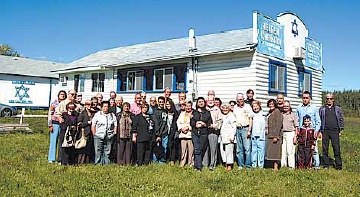
“In recent years the synagogue has seen the addition of a window airconditioner (although to benefit from it, you really have to be sitting just a few feet away), as well as a fridge that allows synagogue attendees to enjoy a regular Saturday morning Kiddush meal following the service.
“According to Laurie Mainster, the Saturday morning service has continued to be popular, even though many of the attendees now drive in from Winnipeg, as they have sold the cottages they once maintained.
“On the other hand, one of the side benefits to being located on Camp Massad’s grounds has been an infusion of young blood from among the camp counsellors.
“Since there is no longer a rabbi available to conduct services (Rabbi Weizman did lead services for years while he had a cottage at the beach), those in attendance now take turns leading the services themselves.
“Anyone may attend services and, while there are no dues collected, donations are welcome. (Donations should be made to the Jewish Foundation of Manitoba, with donors asked to specify that their donations are to be directed to the beach synagogue.)
“Mainster also says that the beach synagogue is now undergoing an expansion, which will be its first in 60 years. An entirely new space measuring 16 x 18 feet is being added – one that will allow for a real Kiddush area. (Until now, a table has been set up in the back of the synagogue and synagogue goers would help themselves to the buffet that is set up each Saturday during the summer. While pleasant enough, it will certainly be more comfortable to have an actual area set aside for the Saturday afternoon after service lunch.)
“As for dress, longtime attendee Abe Borzykowski (in an article written by Sharon Chisvin for the Free Press in 2007) remarked that ‘I don’t think there are many synagogues where people can attend in shorts, T-shirts and sandals and not feel out of place.’ “

As mentioned in that 2010 article, the beach synagogue at that time was about to undergo an extensive remodelling. Here is an article from a January 2011 issue that describes that remodelling process. The article was written by Bernie Sucharov, who has been a longtime member of the beach synagogue:
“The Hebrew Congregation of Winnipeg Beach made a major change to the synagogue this past summer. With the help of many volunteers, Joel Margolese being the project manager, the synagogue was expanded and an addition was built to handle the overflow crowds, as well as to add more space for the kiddush following services.
“The volunteers spent many Sundays during the summer months building the addition. Bad weather caused many delays, but finally the addition was completed one week before the official summer opening.
“The volunteers were: Joel Margolese, Gordon Steindel, Sheldon Koslovsky, Viktor Lewin, Harvey Zabenskie, Nestor Wowryk, Kevin Wowryk, Victor Spigelman, Jerry Pritchard, and David Bloomfield.
“On Sunday, June 25, 2010 a special ceremony was held to affix a mezzuzah to the front entrance door. Gordon Steindel had the honour of affixing the mezzuzah, which was donated by Sid Bercovich and Clarice Silver.
“Refreshments and food for the day were prepared by Phyllis Spigelman, also known as our catering manager. Throughout the summer, Phyllis, Lenore Kagan and other friends prepared the food for our kiddush.
“A sound system was donated by Arch and Brenda Honigman in memory of their father, Sam Honigman z”l. “The system was installed by Joel Margolese and Stevan Sucharov. This will allow the overflow crowd to hear the service in the new addition.
“There were also generous donations of 50 chumashim and an air conditioner. The chumashim were donated by Gwen, Sheldon and Mark Koslovsky. The air conditioner in the new addition was donated by Joel and Linda Margolese.
“The official opening of the synagogue for the summer took place on July 3, 2010. We had an overflow crowd of 70+ people.”
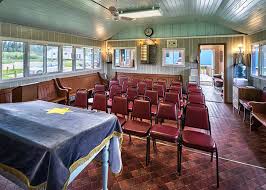
Since that 2010 major addition to the synagogue, it has also added a wheelchair ramp (although I’ve been unable to ascertain exactly when the ramp was built). Also, the synagogue also has its own outdoor privy now. (Attendees used to have to use facilities in Camp Massad.)
And, as already noted in article previously posted to this site (and which you can read at Beach Synagogue about to celebrate 75th anniversary), in recognition of that occasion, on August 2nd members of the synagogue will be holding a 75th anniversary celebration.
As part of the celebration anyone who is a descendant or relative of any of the original members of the first executive committee is invited to attend the synagogue that morning.
If you are a relative please contact Abe Borzykowski at wpgbeachshule@shaw.ca or aborzykowski@shaw.ca to let Abe know you might be attending.
Features
Kinzey Posen: CBC Winnipeg’s former “go-to guy”

By GERRY POSNER If former Winnipegger Lawrence Wall was the CBC go-to guy in Ottawa, CBC Winnipeg had its own version of a go-to guy for many years with none other than the very well known Kinzey Posen. Of course, many readers will recognize that name from his career with Finjan, the Klezmer group so famous across Canada and beyond. It has been written about Posen and his wife Shayla Fink that they have been involved in music since they got out of diapers. And, as an aside, their love and ability in music has now been transmitted to the next generation as in their son, Ariel Posen (but that’s another story).
Kinzey Posen (not to be confused with Posner, or maybe we are to be confused, but who knows for sure?), was a graduate of Peretz School, having attended there from nursery right until Grade 7, graduating in1966. That was followed by Edmund Partridge and West Kildonan Collegiate. Musically, he was in large part self taught. However, he did have some teachers along the way. After moving to Vancouver – from 1974-78, he had the chance to study acoustic classical bass with a member of the Vancouver Symphony Orchestra. When Kinzey lived in Vancouver, he also worked as a jazz musician.
Upon returning to Winnipeg, Kinzey enrolled as a mature student at the University of Winnipeg, where he obtained a Bachelor of Urban Studies degree. Although the degree was in no way connected to the career that followed, his attending the University of Winnipeg was critical to his connecting with the CBC. Why? you ask. Kinzey had a position after graduation working for the Institute of Urban Studies. While there, he met someone who invited him to work for the Department of Continuing Education as one of their program directors. At the time the Department of Continuing Education was located at 491 Portage Avenue, which was also known as the TJ Rice Building. The CBC also leased some space in the same building. According to Kinzey, the CBC part of the building “included HR, different shows and other support offices. Continuing Education was located in the basement and main floor and that’s where I worked.”
KInzey had long had an interest in the CBC, which made the fact that the CBC had some offices in the same building where he was working serendipitous. That Kinzey might be interested in visiting the CBC was not an accident. As a young boy he had a nightly connection to CBC, as it was his ritual to listen to CBC Radio (as well as all sorts of other radio stations across the USA) on his transistor radio every night in bed. He became enamoured of one particular CBC host, Bill Guest, so that when going to sleep, he imagined that he was Guest doing interviews with imaginary guests. That dream of working for CBC became a reality when he had a chance to do a one week gig with Jack Farr’s network program.
Kinzey took a week off from his Continuing Education job and spent five days at the CBC. That week was a training session for Posen, as he had to create ideas, research, pre-interview, write the script, and set up the studio for Farr’s interview. He was almost in his dream job – although not quite – since it was only for one week. His opportunity, however, came in 1988, when he was offered a one-year term as a production assistant – the lowest guy on the ladder, for a show called “ Simply Folk,” with the late Mitch Podolak as the host. Although he was indeed at the bottom as far as those working on the show were concerned, he took a chance and gave his notice to the U of W. The rest is history. In his new job, Kinzey learned how to become a producer. Lucky for him, at the end of the year, when the person he replaced was supposed to come back, she never returned (just like the song, “MTA,” by the Kingston Trio). At that point, Kinzey was hired full time at the CBC.
Kinzey was a fixture at the CBC for 27 years. During those years, Kinzey had the chance to work with Ross Porter, a respected former CBC host and producer, also with Karen Sanders – on the “Afternoon Edition.” One aspect of Kinzey’s job on the Afternoon Edition was to come up with ideas, mix sound effects, arrange interviews and music, to create a two-hour radio experience. In addition, he covered jazz and folk festivals and, as a result, was exposed to some of the best musicians in the world. With Ross Porter in the 1990s, he worked on a network jazz show called “ After Hours,” which was on from 8-10 PM five nights a week. Kinzey was involved with writing the scripts, picking the music, and recording the shows, as well as editing them and then presenting them to the network for playback.
Of course, over his career, Kinzey had many memorable moments. He told me about one of them. The story revolved around the National Jazz Awards one year in particular. The awards were to be broadcasted after the National News which, in those days, began much earlier in the evening, and were over by 8:00 pm. The legendary Oscar Peterson was lined up to play a half hour set at the awards, starting at 7:30. But, as Kinzey told me, Oscar Peterson had a “hate on” for the CBC ecause one of his recorded performances was wrongly edited and he refused to appear on CBC under any circumstances. As the time neared 8:05 PM, which was when the CBC was to begin its broadcast of the jazz awards, it became apparent that Oscar was not going to finish on time. As the producer of the awards show, Kinzey was tasked with telling Oscar Peterson to wrap it up and get off the stage. There was Kinzey Posen, a huge fan of Oscar Peterson, now faced with the prospect of telling Oscar – while he was still playing – with 500 people in the audience, to stop and get off the stage. Not often was or is Kinzey Posen frozen, but that was one such moment. There was one loud “Baruch Hashem” from Kinzey when Oscar completed his set literally just in time.
Clearly, Kinzey was part of a very successful run with After Hours as it was on the air for 14 years. It was easily one of the most popular shows on CBC Radio 2, and a winner of several broadcasting awards. Kinzey also played a major role in producing a two part documentary about legendary guitarist Lenny Breau.
When After Hours ended, Posen became one of the contributing producers to Canada Live and specialized in producing live radio specials for the network, such as the Junos, for CBC Radio One and Two. Needless to say, his career planted Posen in the world of some top notch musicians, including his time spent working with Robert Plant (Led Zeppelin), Dave Brubeck, Randy Bachman, Chantal Kreviazuk and a list of prominent names in the Canadian, American and European music spheres. Locally, the CBC came to refer to Kinzey as the Jewish expert. I would add music expert to that title.
After his 27 year run at the CBC – and before he fully retired, Kinzey went on to work for the Rady JCC as a program director for a year and a half. Of course, to say that Kinzey Posen is retired is a major contradiction in terms. You really can’t keep him down and he has his hand in a variety of programs and projects – most of which he remains silent about, as is his style.
When I realized the full depth and talent of Kinzey Posen, I quickly concluded that he must certainly be related to me. Even if he isn’t, I now tell people he is.
